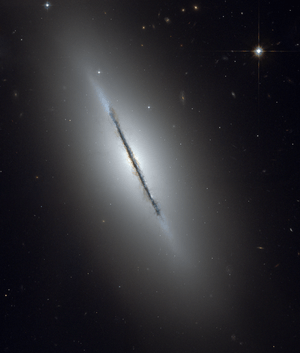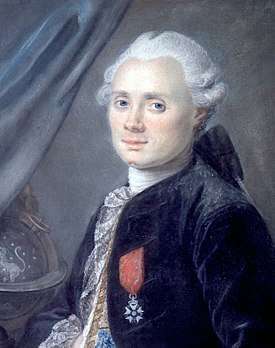NGC 5866
NGC 5866 (also called the Spindle Galaxy or Messier 102) is a relatively bright lenticular or spiral galaxy in the constellation Draco. NGC 5866 was most likely discovered by Pierre Méchain or Charles Messier in 1781, and independently found by William Herschel in 1788. Measured orbital velocities of its globular cluster system[5] imply that dark matter makes up only 34±45% of the mass within 5 effective radii; a notable paucity.
| NGC 5866 | |
|---|---|
 | |
| Observation data (J2000 epoch) | |
| Constellation | Draco |
| Right ascension | 15h 06m 29.5s[1] |
| Declination | +55° 45′ 48″[1] |
| Redshift | 0.002518±0.000017[1] |
| Helio radial velocity | 755±5 km/s[1] |
| Galactocentric velocity | 901±8 km/s[1] |
| Distance | 50 ± 3 Mly (15.3 ± 0.7 Mpc)[2] |
| Apparent magnitude (V) | 10.7[1] |
| Characteristics | |
| Type | S0[1] |
| Size | ~60,000 ly (18,400 pc)[3] |
| Apparent size (V) | 4′.7 x 1′.9[1] |
| Notable features | The galaxy is viewed edge on |
| Other designations | |
| Spindle Galaxy,[4] UGC 9723,[1] PGC 53933[1] | |
Dust lane
One of the most outstanding features of NGC 5866 is the extended dust disk, which is seen almost exactly edge-on.[6] This dust lane is highly unusual for a lenticular galaxy. The dust in most lenticular galaxies is generally found only near the nucleus and generally follows the light profile of the galaxies' bulges.[7][8] This dust disk may contain a ring-like structure, although the shape of this structure is difficult to determine given the edge-on orientation of the galaxy.[8] It is also possible that the galaxy is a spiral galaxy that was misclassified as a lenticular galaxy because of its edge-on orientation, in which case the dust lane would not be too unusual.[7]
Galaxy group information
NGC 5866 is one of the brightest galaxies in the NGC 5866 Group, a small galaxy group that also includes the spiral galaxies NGC 5879 and NGC 5907.[9][10][11] This group may actually be a subclump at the northwest end of a large, elongated structure that comprises the M51 Group and the M101 Group, although most sources distinguish the three groups as separate entities.[12]
See also
References
- "NASA/IPAC Extragalactic Database". Results for NGC 5866. Retrieved 27 October 2017.
- J. L. Tonry; A. Dressler; J. P. Blakeslee; E. A. Ajhar; et al. (2001). "The SBF Survey of Galaxy Distances. IV. SBF Magnitudes, Colors, and Distances". Astrophysical Journal. 546 (2): 681–693. arXiv:astro-ph/0011223. Bibcode:2001ApJ...546..681T. doi:10.1086/318301.
- Hubble site http://hubblesite.org/newscenter/archive/releases/2006/24/image/a/
- "NGC 5866". SIMBAD. Centre de données astronomiques de Strasbourg. Retrieved 30 October 2006.
- Adebusola B. Alabi; Duncan A. Forbes; Aaron J. Romanowsky; Jean P. Brodie; Jay Strader; Joachim Janz; Christopher Usher; Lee R. Spitler; Sabine Bellstedt; Anna Ferre-Mateu (20 May 2016). "The SLUGGS survey: the mass distribution in early-type galaxies within five effective radii and beyond". Monthly Notices of the Royal Astronomical Society. 460 (4): 3838–3860. arXiv:1605.06101. Bibcode:2016MNRAS.460.3838A. doi:10.1093/mnras/stw1213.
- Plait, Phil (17 May 2019). "NGC 5866, an edge-on galaxy, shows off its spectacular dust lane". SYFY WIRE. Retrieved 17 July 2020.
- G. J. Bendo; R. D. Joseph; M. Wells; P. Gallais; et al. (2002). "An Infrared Space Observatory Atlas of Bright Spiral Galaxies". Astronomical Journal. 123 (6): 3067–3107. Bibcode:2002AJ....123.3067B. doi:10.1086/340083.
- E. M. Xilouris; S. C. Madden; F. Galliano; L. Vigroux; et al. (2004). "Dust emission in early-type galaxies: The mid-infrared view". Astronomy & Astrophysics. 416 (1): 41–55. arXiv:astro-ph/0312029. Bibcode:2004A&A...416...41X. doi:10.1051/0004-6361:20034020.
- R. B. Tully (1988). Nearby Galaxies Catalog. Cambridge: Cambridge University Press. ISBN 978-0-521-35299-4.
- Af. Garcia (1993). "General study of group membership. II – Determination of nearby groups". Astronomy and Astrophysics Supplement. 100: 47–90. Bibcode:1993A&AS..100...47G.
- G. Giuricin; C. Marinoni; L. Ceriani; A. Pisani (2000). "Nearby Optical Galaxies: Selection of the Sample and Identification of Groups". Astrophysical Journal. 543 (1): 178–194. arXiv:astro-ph/0001140. Bibcode:2000ApJ...543..178G. doi:10.1086/317070.
- L. Ferrarese; H. C. Ford; J. Huchra; R. C. Kennicutt Jr.; et al. (2000). "A Database of Cepheid Distance Moduli and Tip of the Red Giant Branch, Globular Cluster Luminosity Function, Planetary Nebula Luminosity Function, and Surface Brightness Fluctuation Data Useful for Distance Determinations". Astrophysical Journal Supplement. 128 (2): 431–459. arXiv:astro-ph/9910501. Bibcode:2000ApJS..128..431F. doi:10.1086/313391.
External links
| Wikimedia Commons has media related to NGC 5866. |
- NGC 5866 on WikiSky: DSS2, SDSS, GALEX, IRAS, Hydrogen α, X-Ray, Astrophoto, Sky Map, Articles and images
- SEDS Messier pages: NGC 5866
- NGC 5866 at ESA/Hubble
- NGC5866
